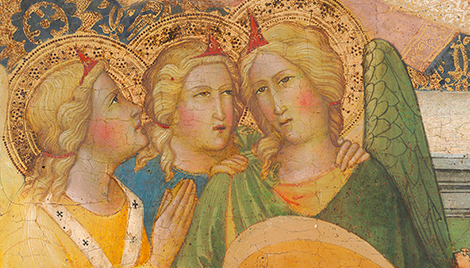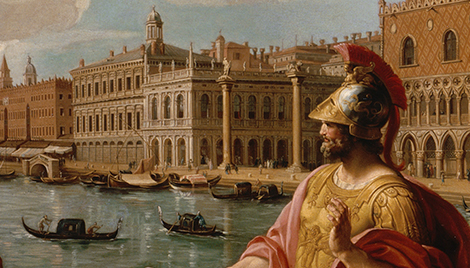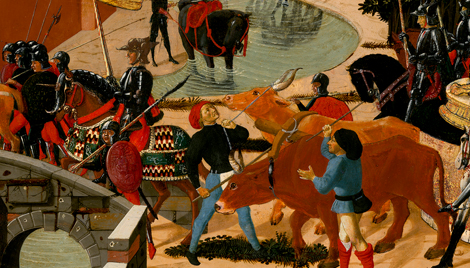Kress Grantee & Fellow Spotlight: Lia Markey, The Newberry Library
Lia Markey is the Director of the Center for Renaissance Studies at Chicago’s Newberry Library where she is responsible for conferences, symposia, workshops, seminars, and digital humanities projects devoted to medieval and early modern studies.
Dr. Markey’s research examines cross-cultural exchange between Italy and the Americas in the sixteenth and seventeenth century, collecting history, and early modern prints and drawings. Publications include Imagining the Americas in Medici Florence (Penn State University Press, 2016) and a co-edited volume The New World in Early Modern Italy, 1492-1750 (Cambridge University Press, 2017). Her edited volume, Renaissance Invention: Stradanus’s “Nova Reperta” (Northwestern University Press, 2020) complemented the Newberry Library’s fall 2020 exhibition by the same title and includes catalog entries as well as contributions from a related Newberry symposium. Most recently, she co-curated the Newberry exhibition Seeing Race Before Race and co-edited a volume with the same name with Noémie Ndiaye (2023).
Dr. Markey teaches at the University of Chicago, Northwestern University, and the University of Illinois Chicago and has held fellowships at the Folger Library, the Warburg Institute, Harvard's Villa I Tatti, the Metropolitan Museum of Art, the Herzog August Bibliothek, the European University Institute in Florence, and the Getty Center. She is currently working on publications related to cartography, Medici patronage, the slave trader Francesco Carletti, and the naturalist Ulisse Aldrovandi.
—
Read on to learn more about Lia’s work at the Newberry, her experience as a Kress Fellow in Florence, and the recent exhibition Seeing Race Before Race, in conversation with Shea Spiller from the Kress Foundation.
Shea Spiller: To start, can you tell me about your current role at the Newberry Library?
Lia Markey: I am the Director of the Center for Renaissance Studies at the Newberry Library. This means I direct a research center, which is a bit unusual here in the U.S. The Center is supported by a consortium of fifty universities, and we organize programming for faculty and students related to premodern studies, ranging in disciplines from the medieval period all the way through the 18th century. I also have the opportunity to curate exhibitions and to work on research, publications, and digital projects, as well as programming related to paleography.
The Newberry Library in Chicago
Is the university consortium made up of schools across the U.S. or is it regional?
Yes, it's across the country and we also have some members from the UK and one from Switzerland. We’ve organized an undergraduate course twice now online, and we hold it in the middle of the day to allow participation of students from California to Aberdeen, Scotland.
And has the Center always been a part of the Newberry?
It began in 1979 under the leadership of the scholar-librarian John Tedeschi as a regional consortium focused on Midwestern schools. It’s developed over time and now we have about fifty schools involved.
I imagine it provides opportunity for such rich dialogue and conversations to have so many different geographies and areas of expertise represented in the group.
Definitely. It’s a very diverse group. Each school is represented by one or two faculty members across a variety of fields, and we meet each year to talk about our programming and we receive great ideas of what we should be doing. Then we collaborate with the faculty to make things happen.
A Newberry fellow looks through an illuminated manuscript from the Newberry's collection
Before we get into your work at the Newberry, I’d like to focus on you and your career. I know that you were a Kress History of Art Institutional Fellow in Florence. Can you tell me a bit about your experience in that program and how it fits into your larger career trajectory?
I was just thinking that it was this time about 20 years ago that I started working on my application for the Institutional Fellowship program to support my dissertation research. At the time, my dissertation topic was perhaps a bit unusual because I was exploring the representation and collection of the Americas in collections in Medici Florence in the 16th century. Nonetheless, Kress awarded me the Fellowship. Through the Kress Fellowship, I had a productive and wonderful experience at the Kunsthistorisches Institut in Florence with a great community of scholars where I was able to develop the project and had access to the archives and all the museum collections in Florence. So, it was really thrilling, and I'm very grateful to Kress for that. And then that dissertation transformed into a book which has led me to other related projects that Kress has also funded.
Your dissertation sounds so interesting. Were you mostly working with printed materials representing the Americas?
It was multimedia, so I looked at everything from the objects that were coming to Florence from the Americas, like feather painting and mosaic masks, to fresco paintings in the Uffizi representing Indigenous people as well as ephemeral activities and festivals, prints, engravings, book illustrations, tapestries, and paintings.
Oh, that sounds so fascinating and rich.
And that’s a great segue into my questions about the exhibition you organized at the Newberry, Seeing Race Before Race. I imagine some of those themes and early ideas were rooted in that project as well. Could you just tell me about how the project first came about?
Part of the project did come about due to my feelings of frustration at not being able to deal with race sufficiently in the dissertation and later in the book project—I finished my dissertation in 2008 and my book was published in 2016. Although Premodern Critical Race Studies (PCRS) was flourishing in English studies, it hadn’t quite reached art history and it wasn’t something that I had studied.
After taking this job on at the Newberry, I was introduced to scholars in the field of PCRS, specifically through Arizona State University’s project RaceB4Race and through Noémie Ndiaye here at the University of Chicago. We learned that there was going to be a conference in Chicago connected to RaceB4Race and we thought it would be a great opportunity to highlight the Newberry’s collections and to think about race in relationship to our materials.
The exhibition derived from that collaboration with Noémie. It then grew into a larger collaborative project with a book and experts from different disciplines. It was my goal as an art historian to bring art history into the discourse of PCRS. We’re all really grateful to Kress for helping us with the book, which turned out to be a beautiful publication. It’s been very gratifying to be able to push the field a little further in that regard.
We're hoping to continue the work over the next few years. We host a “Race in Dialogue” series online and have exciting sessions coming up focused on art history and then book history. So we're keeping the conversation going that way with regular sessions recorded and then archived on YouTube. We're also planning a symposium focused on PRCRS (December 6-7, 2024) organized by our former postdoctoral fellow, Yasmine Hachimi (UC Santa Barbara), specifically with a group of interdisciplinary early career scholars. This will also take place online in order to create a larger international community.
The Seeing Race Before Race volume won the Prose award for best exhibition.
That’s amazing. And that was actually my next question: How do you see the lasting impact and living work of this project? It’s so exciting to hear that you already have programs in place to keep that work going.
Thanks to another Kress grant we were able to develop digital initiatives related to the project as well. We created a story map, which was up in the gallery at the time and now lives on the internet, and now we're finishing up a Digital Collection for the Classroom, which provides teacher resources for studying visual materials connected to race from the period. The materials are designed for high school, but I think they’ll be useful for the undergrad classroom as well.
What was or continues to be one of the more surprising outcomes of the project for you?
I’m not sure if this was surprising per se, but the response to the exhibition was incredibly positive. We created a response wall for visitors to comment on their experience in the exhibition, and the text on those cards were really powerful. It was lovely to see the positive response and how it transformed the way people thought about ideas of race today.
During the run of the show, what kinds of public programming were you doing to help bring in a greater diversity of visitors?
We organized some fantastic public programs that endeavored to connect the past with the present. For example, we hosted performances by actors from Congo Square, a local theater group here in Chicago, who performed scenes from Shakespeare and some other plays. We then paired the actors with scholar, Vanessa Corredera (Andrews University), who studies race and Shakespeare, and a beautiful conversation ensued. We also hosted a conversation with the Italian filmmaker Daphne Di Cinto and screened her film Il Moro (The Moor), which is about Alessandro de’ Medici who was the first Black Duke of Florence. She shared about her experiences making the film and its contemporary resonance today.
Il Moro – The Moor. Director Daphne Di Cinto with actors Andrea Melis (left) Alberto Boubakar Malanchino (center), Paolo Sassanelli (right). Photo: Resina. COURTESY
GRIOTI know Kress has funded other exhibitions that you’ve worked on at the Newberry, as well as the European Art Seminar. Would you like to touch upon any of those projects?
Kress funding began at the Newberry before my time. Starting back in 2012 Kress supported some short-term fellowships at the Newberry. In recent years, Kress supported a Center symposium devoted to emblem studies and the Renaissance Invention exhibition which was focused on Stradanus’s renowned Nova Reperta print series.
Gallery view of the “Renaissance Invention” exhibition in fall 2020.
Our ongoing Kress European Art Seminar began in 2015 and will soon mark its tenth anniversary. We’re incredibly proud of the Seminar, which meets a few times a year and places two scholars in conversation. The scholars present pre-circulated papers and then we discuss their work as a group, along with Newberry materials related to their projects. Our curator Suzanne Karr Schmidt is very skilled at pulling out related materials that you wouldn’t otherwise think of. Nearly each one of these pre-circulated papers has turned into a publication, as a book chapter or an article, so we are particularly happy to see the Kress seminar continue on as a premiere space for the development of art historical projects in premodern studies.
The program is open to the public, and we usually get a combination of regular attendees as well as Newberry Fellows and other folks who happen to be interested in the topic. This fall we’ll host a seminar with James Clifton (Sarah Campbell Blaffer Foundation) and Jessica Keating (Carleton College).
Edina Adam, Jamie Gabbarelli, and Emanuele Lugli lead a collection presentation at the European Art Seminar with Sheryl Reiss and Maria Vittoria Spissu in attendance.
I understand that the Newberry’s collection spans over six centuries and almost the entire globe. You also have a strong commitment to European art and art history. Can you speak more about how European art history, and art history in general, fits within the larger work of the Newberry?
As an art historian, to me everything is visual material. Every object I look at, even if it’s purely textual, I think of it as an object—as a material thing that is moving through space with a social history of its own.
As I’ve become more immersed in book history, I’ve learned that book history is essentially very much the same as art history. We ask the same questions about materials, considering how they functioned, and how their users engaged with them. Those questions are at the heart of everything we do. Even if it’s not necessarily visual, there’s a material component to almost all of our activities. Aside from that, we have a very rich collection of books with images, including early printed books with woodcuts and engravings, illuminated manuscripts, and cartography. I should also note that the library holds single sheet prints and various ephemera as well. Curator Suzanne Karr Schmidt is currently researching an exhibition on printing on fabric that will open in fall 2026.
Art history is really at the center of much of what we're doing, even when our work is quite interdisciplinary. Our paleography program is also intimately tied to the study of visual and material culture and being able to engage with manuscripts in an object-focused way.
Can you tell me more about that program?
Paleography is the study of old handwriting. Every region and period possesses different styles of handwriting that are very different from our own today. So reading documents from the medieval and Renaissance periods can be quite challenging. Paleography training also encompasses the material study of manuscripts and codicology.
We offer paleography training over the summer in Italian, Spanish, and French, and we’re one of the only institutions in the US that offers these courses for scholars. What's great is that the Newberry holds documents here that provide examples of handwriting in the seminars. We’ve also built websites that include software that allows students to practice paleography online with more than 100 documents of different genres and from different periods.
Accessibility is at the heart of paleography training. At first, paleography doesn't seem like it's part of that conversation, but it is so essential because it provides people with the ability to read and engage with archival documents that are otherwise inaccessible. Through these documents new stories can be told about the past.
Italian Paleography at the Newberry
To end with, what is something that makes you most excited to be working in this field right now and looking ahead to the future?
What’s been exciting for me is to see how the field of art history, particularly early modern art history, is making itself more relevant for today's world by dealing with contemporary issues like gender, colonization, and race. Seeing Race Before Race is one example of the impact this kind of collaborative scholarship can have.
—



